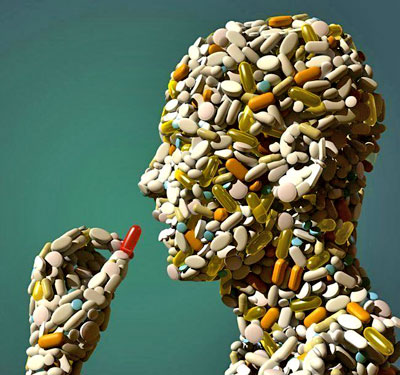|
December 29, 2011
You May Have a
New Disorder with the Stroke of a Pen
This book possesses the definition of
every single disorder known to man, and also every disorder invented
by man.
If you are a 296.22, you have
experienced a single mild episode of major depressive disorder,
while if you are a 301.83 you very close to having personality
disorder.
With a few simple strokes in this book,
every single person in the country could soon be labeled as having a
disorder, whether caught by medical "professionals" or not.
You may or may not be surprised to know
that your child "has ADD" so long as 6 of 9 boxes from a list of
symptoms are checked; symptoms like "often does not seem to listen
when spoken to directly" or "often fidgets with hands or feet or
squirms in seat."
With the approval of these disorders,
there will undoubtedly be a dramatic increase in powerful
antipsychotic drug use. These drugs which
breed overweight, diabetic
children, rose to the top in 2008 with over $14 billion in sales,
and have been pushed on millions of children since 2009 alone.
No matter the final decision, this book has been helping the pharmaceutical industry for decades, while causing millions of people to suffer from unnecessary medications.
The vicious profit-driven cycle brought
to you by the pharmaceutical industry only leads you to become
dependent on their products, while heavily contributing to the
decline of legitimate health practices.
Therapists Revolt Against Psychiatry's Bible
Mental Health Professionals Say New Diagnoses
Will Lead to Overmedication from Salon Website
Your mental illness
defined here
Anyone who's ever tried to get
reimbursed by a health insurance company after seeing a psychiatrist
or psychotherapist, or taking a child or teenager to one, has no
doubt noticed the incomprehensible numbers that appear on the
clinician's statement, perhaps preceding some slightly less
imponderable phrase.
Hopefully, you are not a 301.83
(borderline personality disorder). Your kid might be a 313.81
(oppositional defiant disorder) or, more likely, a 314.01 (attention
deficit hyperactivity disorder, predominantly hyperactive-impulsive
type).
This bible of mental health treatment,
published by the American Psychiatric Association (APA),
provides a list and description of every mental health condition
known to - or invented by - psychiatry, from histrionic personality
disorder (301.50) to transvestic fetishism (302.3).
The number of listed disorders tripled to nearly 300.
A few have been discredited and dumped along the way. Most famous were battles over the inclusion of homosexuality. Successive iterations of the manual listed homosexuality as a "sociopathic personality disturbance," then modified that to describe a more limited "sexual orientation disturbance" among people who were "in conflict with" their attraction to people of the same sex.
That was later replaced by a disorder
called "ego-dystonic homosexuality," applied to those whose
homosexual arousal was a source of distress. That item was dropped
in the DSM-III-R, published in 1987.
The chief complaint is that the newest
version will lower the criteria needed to diagnose some conditions,
creating "subthreshold" disorders, and generally making it easier
for healthcare professionals to label a person with a psychiatric
disorder and medicate him or her.
In June, a special committee of the British Psychological Society complained in a letter to the APA that,
The committee criticized the proposed creation of an,
They also objected to a proposed
reduction in the number of symptoms needed to diagnose adolescents
with attention deficit disorder (ADD) because it might increase
diagnoses and the use of meds.
In October, he posted the petition online.
The response stunned him and his colleagues.
The petition attracted more than 6,000 signatures in three weeks; as of mid-December it had topped 9,300 signatories and garnered the endorsement of 35 organizations.
On Nov. 8, American Counseling Association president Don Locke jumped in with a letter to the APA objecting to the,
For many critics, Exhibit A is childhood ADD.
As the disorder describing fidgety, easily distracted kids morphed from "hyperkinetic reaction of childhood" to the current "attention deficit hyperactivity disorder," the number of children given the diagnosis exploded, fueling, by one account, a 700 percent increase in the use of Ritalin and other stimulants in the 1990s.
Diagnosis requires checking six of nine boxes from a list of symptoms that include,
Sound familiar, parents?
Both lack a solid basis in research and may fuel the use of powerful antipsychotic medications, which cause weight gain, diabetes and a host of other metabolic problems, the petition says.
David Kupfer, the University of Pittsburgh psychiatrist who chairs the task force overseeing the manual's preparation, says he expects the final number of disorders included in the DSM-5 to be about the same as in the current book.
He says he welcomes the criticism and that nothing is final.
The task force has been testing proposed new diagnoses in 2,300 patients at seven adult treatment centers and four adolescent centers that are acting as field-test sites, he says.
The most surprising critic of the DSM is a one-time pillar of the psychiatric establishment.
Allen Frances, professor emeritus at
Duke University, chaired the task force that created the DSM-4. Now
he's railing against both the process and proposed content of the
new DSM in blogs on the website for
Psychology Today that blast the
new revision as "untested" and "unscientific."
The user revolt against the DSM-5 has emerged as a major challenge to the document, Frances says, and its future is looking unclear.
He and Elkins are proposing that an
independent committee of experts review the proposed draft and make
recommendations.
For people seeking help for life's
problems who don't want to be labeled mentally ill or have their
treatment limited to medication, and for clinicians who want to help
people without reducing them to a category, the stakes are high.
|



